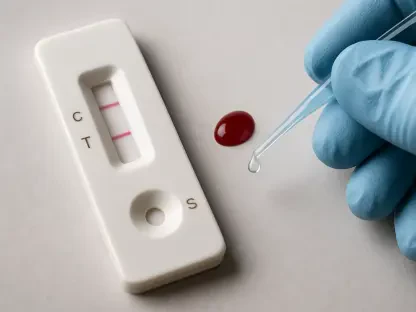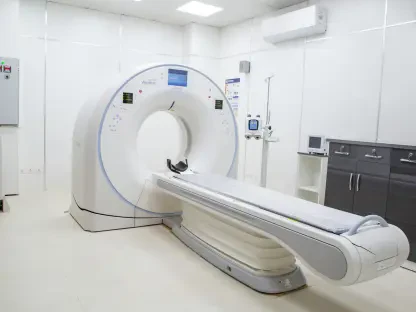The medical-grade collagen market is poised for extraordinary expansion, with recent projections estimating a near doubling in value from USD 1.001 billion in 2024 to an impressive USD 1.992 billion by 2035, driven by a steady compound annual growth rate (CAGR) of 6.45% over the next decade from 2025 to 2035. This remarkable growth highlights the escalating significance of collagen as a critical biomaterial in the healthcare sector. Renowned for its exceptional biocompatibility and adaptability, medical-grade collagen is transforming treatment methodologies across diverse fields such as orthopedic surgery, wound care, and cosmetic procedures. As the medical landscape continues to evolve, the demand for innovative and dependable solutions is surging, positioning collagen at the forefront of addressing complex health challenges. This trajectory not only reflects technological advancements but also underscores a broader shift toward advanced regenerative therapies that promise better patient outcomes in an increasingly health-conscious world.
Market Dynamics and Growth Drivers
Rising Demand in Healthcare
The escalating need for medical-grade collagen in healthcare applications is a primary catalyst for market growth, spanning a wide array of treatments from chronic wound management to intricate cosmetic enhancements. Chronic conditions such as diabetic ulcers and pressure sores are becoming more prevalent, necessitating advanced biomaterials that can accelerate healing and reduce infection risks. Simultaneously, the surge in aesthetic procedures, fueled by societal emphasis on appearance and wellness, has amplified the use of collagen in dermal fillers and skin rejuvenation therapies. Orthopedic applications also play a significant role, as collagen-based scaffolds and implants are increasingly utilized in joint repair and bone regeneration. This multifaceted demand is further intensified by a growing awareness among patients and healthcare providers about the benefits of biocompatible materials, driving adoption across hospitals and specialized clinics globally.
Another dimension of this rising demand stems from the evolving preferences of patients who prioritize treatments that offer minimal downtime and enhanced recovery. Medical-grade collagen fits seamlessly into this trend, particularly in minimally invasive procedures where it supports tissue repair without the complications associated with synthetic alternatives. The material’s ability to mimic natural tissue structures makes it a preferred choice for surgeons tackling complex reconstructions, especially in dental and maxillofacial surgeries. Additionally, the increasing incidence of sports-related injuries among younger demographics has spurred the need for reliable biomaterials to aid in ligament and cartilage repair. As healthcare systems worldwide adapt to these diverse needs, the market for medical-grade collagen is experiencing unprecedented interest, setting the stage for sustained expansion over the coming years.
Impact of Aging Population and Chronic Conditions
The aging global population stands as a significant driver behind the growing reliance on medical-grade collagen, particularly as age-related ailments become more widespread. Conditions like osteoarthritis, which affects millions of elderly individuals, require innovative solutions for joint repair and pain management, where collagen-based products offer promising results due to their regenerative capabilities. As life expectancy rises, so does the incidence of degenerative diseases, pushing healthcare providers to seek materials that can support long-term tissue health. This demographic shift is creating a consistent demand for collagen in applications such as spinal implants and cartilage regeneration, ensuring that the material remains integral to geriatric care strategies across developed and emerging markets alike.
Beyond aging, the rise in chronic conditions across all age groups further fuels the market’s momentum, with diabetic foot ulcers and venous leg ulcers representing critical areas of need. These conditions, often compounded by lifestyle factors such as obesity and sedentary habits, necessitate advanced wound care solutions that can prevent complications like amputation. Medical-grade collagen, with its ability to promote cellular growth and tissue integration, is increasingly incorporated into dressings and matrices designed for such complex cases. Hospitals and wound care centers are prioritizing these biomaterials to improve patient outcomes, particularly in regions with high diabetes prevalence. This convergence of demographic and health trends underscores the indispensable role of collagen in modern medicine, reinforcing its position as a vital component in addressing some of the most pressing healthcare challenges today.
Innovation and Technological Advancements
Research and Development Breakthroughs
Research and development (R&D) efforts are at the core of the transformative changes sweeping through the medical-grade collagen market, with substantial investments paving the way for groundbreaking innovations. Biotechnology firms are dedicating resources to explore the full potential of collagen, focusing on enhancing its properties to meet stringent clinical demands. One of the most notable areas of progress is the development of synthetic and recombinant collagen, which offers a viable alternative to traditional animal-derived options. These innovations aim to eliminate variability in product quality and address ethical concerns surrounding animal sourcing, thereby broadening the appeal of collagen-based solutions. Such advancements are not only refining existing applications but also opening new avenues in tissue engineering and regenerative therapies.
Equally important is the emphasis on improving purification techniques and manufacturing processes to ensure that medical-grade collagen meets the highest safety and efficacy standards. Advanced bioengineering methods are being employed to tailor collagen structures for specific medical uses, such as creating scaffolds with enhanced tensile strength for orthopedic implants. These R&D initiatives are often supported by academic institutions and government grants, fostering a collaborative environment that accelerates the pace of discovery. The result is a steady stream of next-generation collagen products that promise better integration with human tissues and reduced risk of adverse reactions. As these technological strides continue, they are reshaping the landscape of medical treatments, ensuring that collagen remains a cornerstone of innovation in healthcare over the forecast period.
Shift to Synthetic and Recombinant Collagen
A notable trend within the medical-grade collagen market is the growing shift toward synthetic and recombinant collagen, driven by both technological progress and evolving ethical considerations. Unlike traditional sources such as bovine or porcine collagen, synthetic variants are engineered in controlled lab environments, ensuring consistency in composition and minimizing the risk of allergic reactions or disease transmission. This approach aligns with increasing consumer and regulatory demands for sustainable and cruelty-free medical products, making synthetic collagen an attractive option for manufacturers aiming to capture a broader market share. The precision of these alternatives also allows for customization to suit specific therapeutic needs, enhancing their applicability across diverse clinical scenarios.
This transition is further supported by advancements in genetic engineering, which enable the production of recombinant collagen through microbial fermentation or plant-based systems, offering a scalable and environmentally friendly solution. Such methods reduce dependency on animal-derived materials, addressing supply chain vulnerabilities and ethical dilemmas that have long plagued the industry. Additionally, synthetic collagen’s uniformity supports more predictable outcomes in medical applications, from wound dressings to cosmetic injectables, fostering greater trust among healthcare professionals. As public awareness of sustainability grows, alongside regulatory incentives for greener practices, the adoption of these alternatives is expected to accelerate, marking a pivotal shift in how medical-grade collagen is sourced and utilized in the years ahead.
Regulatory and Collaborative Landscape
Importance of Regulatory Standards
The medical-grade collagen market operates within a stringent regulatory framework that plays a crucial role in ensuring product safety and efficacy, thereby building trust among stakeholders. Regulatory bodies across the globe impose rigorous guidelines on the production and application of collagen-based medical products, mandating comprehensive testing for biocompatibility and sterility to prevent adverse patient outcomes. Compliance with these standards is non-negotiable, as it directly impacts market acceptance and the ability of manufacturers to introduce innovations. This oversight not only safeguards public health but also enhances the credibility of collagen as a reliable biomaterial, facilitating its integration into mainstream medical practice and driving broader adoption across various therapeutic areas.
Moreover, regulatory standards serve as a benchmark for quality, compelling companies to invest in advanced manufacturing processes and quality control measures to meet or exceed expectations. This often involves navigating complex approval processes, which, while time-consuming, ultimately contribute to market stability by weeding out substandard products. The harmonization of regulations in key regions also aids in streamlining international trade, allowing for faster dissemination of cutting-edge collagen solutions. As a result, adherence to these guidelines fosters a competitive environment where innovation is balanced with accountability, ensuring that patients and healthcare providers can rely on the consistent performance of collagen-based therapies in critical applications.
Strategic Partnerships in Biotech
Strategic collaborations between biotech firms and medical device manufacturers are instrumental in propelling the medical-grade collagen market forward, fostering an ecosystem of innovation and efficiency. These partnerships leverage complementary expertise, combining biotechnological advancements with practical device integration to develop cutting-edge collagen products tailored for specific medical needs. Joint ventures often focus on accelerating the transition from research to commercialization, ensuring that novel solutions such as bioabsorbable implants or advanced wound dressings reach the market swiftly. This collaborative approach not only mitigates the financial risks associated with R&D but also enhances the scope of product development through shared resources and knowledge exchange.
Additionally, such alliances are pivotal in navigating the complex regulatory landscape, as partners can pool their experience to streamline compliance processes and secure approvals more effectively. Collaborations often extend to clinical trials, where combined efforts help validate the safety and efficacy of new collagen formulations under real-world conditions. This synergy is particularly evident in the development of specialized applications, such as collagen matrices for tissue regeneration, which require both material science innovation and medical device precision. By fostering these strategic relationships, the industry ensures a continuous pipeline of high-quality, market-ready solutions, ultimately benefiting patient care and reinforcing the market’s growth trajectory over the long term.
Market Segmentation and Future Outlook
Versatility Across Applications
The medical-grade collagen market is characterized by its remarkable versatility, as evidenced by its segmentation across various forms, sources, and applications that cater to a wide spectrum of clinical requirements. Available in forms such as gels, powders, and implants, collagen adapts seamlessly to diverse therapeutic contexts, whether it’s providing structural support in orthopedic surgeries or acting as a filler in cosmetic enhancements. Sources range from traditional bovine and porcine to human and synthetic options, each offering unique benefits tailored to specific medical needs. Applications span wound healing, dental procedures, and tissue scaffolding, demonstrating collagen’s integral role in addressing multifaceted health challenges with precision and efficacy.
This segmentation also highlights the material’s adaptability to different product types, including injectables for aesthetic treatments and bioabsorbable matrices for surgical repairs, ensuring that healthcare providers have a broad array of tools at their disposal. Physical forms like liquid, solid, and semi-solid further enhance this flexibility, allowing for customized delivery methods suited to patient conditions. The ability of collagen to meet such varied demands underscores its value as a cornerstone biomaterial, driving its penetration into both established and emerging medical fields. As manufacturers continue to refine these segments, the market is poised to address an even wider range of clinical scenarios, solidifying collagen’s relevance in modern healthcare solutions.
Emerging Trends in Regenerative Medicine
Looking ahead, the medical-grade collagen market is set to be profoundly influenced by emerging trends in regenerative medicine, where collagen’s role as a scaffold for tissue repair and growth is gaining prominence. This field focuses on restoring damaged tissues and organs through innovative approaches, with collagen providing the structural framework necessary for cell proliferation and integration. The material’s natural compatibility with human biology makes it ideal for applications such as skin regeneration for burn victims or cartilage repair for joint injuries. As research progresses, the potential for collagen to support stem cell therapies and organ reconstruction is becoming increasingly evident, promising revolutionary advancements in patient care over the next decade.
Another significant trend shaping the future is the growing emphasis on minimally invasive procedures, which rely heavily on collagen-based products for their efficacy and reduced recovery times. Patients and clinicians alike are gravitating toward treatments that minimize surgical intervention, such as injectable collagen solutions for facial rejuvenation or wound management systems that promote healing without extensive procedures. The rise of synthetic collagen also complements this trend, offering ethical and consistent alternatives that align with modern healthcare values. Backed by continuous R&D efforts, these developments signal a dynamic evolution for the market, with regenerative medicine and minimally invasive techniques poised to redefine therapeutic possibilities and enhance quality of life for countless individuals.









